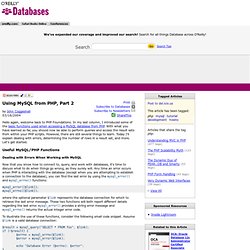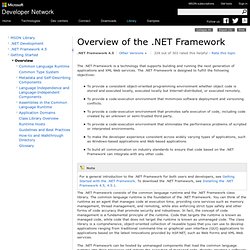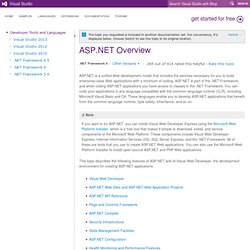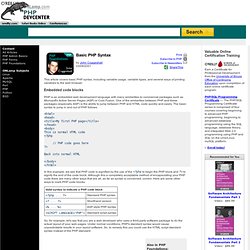

MySQL or SQL Server: Look beyond politics and hype when deciding which to use. MySQL may be free, but what if money isn't the only determining factor?

Python Programming Language – Official Website. The Perl Programming Language - www.perl.org. The world's most popular open source database. Choosing an API. 13.2.8 SELECT Syntax. 11.1 Data Type Overview. Using MySQL from PHP. By John Coggeshall 02/19/2004 Welcome back to PHP Foundations.

My previous column finished the crash course on using MySQL to store and retrieve data from a database using the Structured Query Language (SQL). In today's column, I will begin to use everything I have shown you thus far to work with and create database-driven web pages using PHP. Using MySQL from PHP, Part 2.
By John Coggeshall 03/18/2004 Hello again, welcome back to PHP Foundations.

In my last column, I introduced some of the basic functions used when accessing a MySQL database from PHP. With what you have learned so far, you should now be able to perform queries and access the result sets from within your PHP scripts. However, there are still several things to learn. Today I'll explain dealing with errors, determining the number of rows in a result set, and more. MySQL Functions. Here a mysql helper containing the main functions of the mysql extension.

It's easy to understand for a beginner and quite useful because queries are secure. It understands what you want, just write your sql query. I called it mysql_magic. <? Php$nb_affected = mysql_magic('delete from users');$nb = mysql_magic('select count(*) from users');$one_row = mysql_magic('select * from users limit 1');$all_rows = mysql_magic('select * from users where name = ? ' Welcome! - The Apache HTTP Server Project.
Overview of the .NET Framework. The common language runtime manages memory, thread execution, code execution, code safety verification, compilation, and other system services.

These features are intrinsic to the managed code that runs on the common language runtime. With regards to security, managed components are awarded varying degrees of trust, depending on a number of factors that include their origin (such as the Internet, enterprise network, or local computer). This means that a managed component might or might not be able to perform file-access operations, registry-access operations, or other sensitive functions, even if it is being used in the same active application. The runtime enforces code access security. Home : The Official Microsoft IIS Site. Web Platform - Server, IIS, Internet Information Services. Internet Information Services (IIS) 8.5 in Windows Server 2012 R2 provides a secure, easy-to-manage, modular and extensible platform for reliably hosting websites, services and applications.

With IIS, you get choice and control without giving up reliability or security. Customize and add new features, such as application request routing and load balancing through free IIS Extensions. Maximize web security through a reduced server foot print and automatic application isolation. Easily deploy and run both ASP.NET and PHP web applications on the same server. Visual C# Resources. ASP.NET Overview. The topic you requested is included in another documentation set.

For convenience, it's displayed below. Choose Switch to see the topic in its original location. ASP.NET is a unified Web development model that includes the services necessary for you to build enterprise-class Web applications with a minimum of coding. Hypertext Preprocessor. An Introduction to PHP. What exactly is PHP anyway?

PHP is short for what is officially called "PHP: Hypertext Preprocessor. " PHP was created by Rasmus Lerdorf, a developer who needed a tool to keep track of who was looking at his resume. The first version of Lerdorf's preprocessor (known then as PHP/FI) was released in 1994. Basic PHP Syntax. By John Coggeshall 03/08/2001 This article covers basic PHP syntax, including variable usage, variable types, and several ways of printing variables to the web browser.

Embedded code blocks PHP is an embedded web development language with many similarities to commercial packages such as Microsoft's Active Server Pages (ASP) or Cold Fusion. One of the similarities between PHP and these packages (especially ASP) is the ability to jump between PHP and HTML code quickly and easily. The basic syntax to jump in and out of PHP follows: Control Structures. If you are not sure what will work in your IF statements, try DISECTING your variables.

Below I've written three (3) empty CLASS DEFINITIONS (Point, Dimension, and Rectangle), and declared an array called $items that holds all the PHP types you can imagine -- booleans, strings, empty strings, integers, floats, null, arrays, empty arrays, and objects too. The rest of the code really chews up the current $item and spits it out for lunch... Try running this code so you can see the HTML TABLE that is created -- it'll be worth your while. Arrays. Superglobals. Error Control Operators. If you use the ErrorException exception to have a unified error management, I'll advise you to test against error_reporting in the error handler, not in the exception handler as you might encounter some headaches like blank pages as error_reporting might not be transmitted to exception handler.
So instead of : PHP Error Handling. Include. Htmlspecialchars. Problem In many PHP legacy products the function htmlspecialchars($string) is used to convert characters like < and > and quotes a.s.o to HTML-entities. That avoids the interpretation of HTML Tags and asymmetric quote situations. Since PHP 5.4 for $string in htmlspecialchars($string) utf8 characters are expected if no charset is defined explicitly as third parameter in the function. Legacy products are mostly in Latin1 (alias iso-8859-1) what makes the functions htmlspecialchars(), htmlentites() and html_entity_decode() to return empty strings if a special character, e. g. a German Umlaut, is present in $string: Three alternative solutions. Apache Tomcat - Welcome! Technologies.